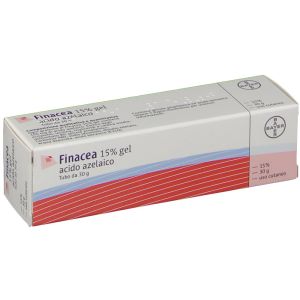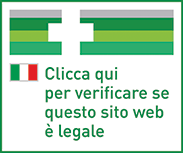Ship in Europe, Find out rates!
Finacea Gel 15% Acido Azelaico Rosacea 30g

- box Delivery in Italy in 24/48 and free returns
- star3.000+ positive reviews
- dropboxOver 60,000 products in the catalog
Gel based on azelaic acid.
Therapeutic indications
Finacea Gel is used for the relief of mild to moderate papulopustular acne on the face and for the topical treatment of papulopustular rosacea.
Dosage and Posology
The drug should be taken according to the following doses and methods: apply on the skin area to be treated twice a day (in the morning and in the evening), making it penetrate with a light massage. The amount of product sufficient for the whole face is approximately 2.5 cm, which corresponds to 0.5 g of gel.
Use in adolescents (12-18 years) for the treatment of acne vulgaris. No dose adjustment is required when Finacea gel is administered to adolescents aged 12-18 years. The safety and efficacy of Finacea gel for the treatment of acne vulgaris in children under the age of 12 have not been established. The safety and efficacy of Finacea gel for the treatment of papulopustular rosacea in children under the age of 18 have not been established.
Before applying Finacea Gel, wash the skin thoroughly with water and dry it. It is also possible to use a mild skin cleanser. Avoid using occlusive clothing or bandages and wash your hands after applying the gel. In case of skin irritation (see section 4.8 "Undesirable effects"), decrease the quantity of gel for each application, or reduce the frequency of use of Finacea Gel to once a day until the irritation disappears. If necessary, stop the treatment for a few days. It is important to use Finacea Gel continuously for the duration of the treatment. The duration of treatment with Finacea Gel may vary from patient to patient and also depends on the severity of the skin disease.
- Acne: In general, there is a noticeable improvement after 4 weeks. For best results, Finacea Gel treatment can be continued for several months according to the clinical outcome. In case there is no improvement after 1 month or in case of acne exacerbation, stop using Finacea Gel and consider other therapeutic alternatives.
- Rosacea: In general there is a noticeable improvement after 4 weeks. For best results, Finacea Gel treatment can be continued for several months according to the clinical outcome. In case there is no improvement after 2 months or in case of rosacea exacerbation, stop using Finacea Gel and consider other therapeutic alternatives.
Overdose
Given the very low toxicity of azelaic acid, locally and systemically, intoxication is unlikely.
Contraindications
Hypersensitivity to the active substance or to any of the excipients.
Side effects
The most frequently observed side effects in clinical trials and post-marketing surveillance included itching, burning and pain at the application site. The frequencies of undesirable effects observed in clinical trials and post-marketing surveillance and listed below in the table were defined according to the MedDRA frequency convention: Very common (≥1 / 10); Common (≥1 / 100, <1/10); Uncommon (≥1 / 1000); <1/100), Rare (≥1 / 10,000, <1/1000); Very rare (<1 / 10,000), Not known (cannot be estimated from the available data).
- Disorders of the immune system
- Rare: Drug hypersensitivity, worsening of asthma
- Skin and subcutaneous tissue disorders
- Uncommon: Contact dermatitis, acne *
- General disorders and administration site conditions
- Very common: Application site burning, application site pain, application site pruritus
- Common: Application site rash, application site paraesthesia, application site dryness, application site edema *
- Uncommon: Application site erythema, application site exfoliation * *, application site warmth * *, application site discoloration * * application site urticaria *, application site discomfort *.
* for the rosacea indication ** for the acne indication
Generally, local skin irritation subsides during the course of treatment.
Treatment of acne vulgaris in adolescents aged 12-18 years: In 4 phase II and II / III clinical trials that included adolescents aged 12-17 years (120/383; 31%), the incidence Total adverse events for Finacea Gel were similar for age groups 12-17 years (40%), age groups ≥18 years (37%) and for the whole patient population (38%). This similarity was also found for the 12-20 year age group (40%).
Pregnancy and breastfeeding
There are no adequate and well-controlled studies of the topical administration of azelaic acid in pregnant women. Animal studies do not indicate direct or indirect harmful effects with respect to pregnancy, embryonal / fetal development, parturition or postnatal development. Caution should be exercised when prescribing azelaic acid to pregnant women.
It is not known whether azelaic acid is excreted in human milk in vivo. However, an in vitro test performed with equilibrium dialysis technique showed that the drug can pass into breast milk. The distribution of azelaic acid in breast milk, however, is not expected to cause a significant change from baseline milk azelaic acid levels, as azelaic acid is not concentrated in milk and less than 4% of the acid. Topically applied azelaic is absorbed systemically, not increasing exposure to endogenous azelaic acid above physiological levels. However, caution is required when Finacea Gel is administered to a nursing woman. Newborns should not come into contact with the skin / breasts treated with the product.
Special warnings
Finacea Gel contains benzoic acid which is mildly irritating to the skin, eyes and mucous membranes, and propylene glycol, which can cause skin irritation. Carefully avoid contact with eyes, mouth and other mucous membranes, and instruct patients appropriately in this regard (see section 5.3 “Preclinical safety data”). In case of accidental contact, wash eyes, mouth and / or affected mucous membranes with plenty of water. If eye irritation persists, consult a doctor. Wash your hands after each application of Finacea Gel. It is advisable to avoid the concomitant use of alcohol-based cleansers, tinctures and astringent products, products with abrasive or exfoliating (peeling) action in patients who use Finacea Gel for the treatment of rosacea. During post-marketing surveillance, worsening of asthma has rarely been reported in patients treated with azelaic acid.
Expiry and retention
Check the expiration date indicated on the package. The expiry date indicated on the package refers to the product in intact packaging, correctly stored. This medicine does not require any special storage conditions.
Warning : do not use the medicine after the expiry date indicated on the package.
Composition
1 gr of Finacea Gel contains:
Active principle
150 mg (15%) of azelaic acid
Excipients
Lecithin, Triglycerides (medium chain), Polysorbate 80, Propylene glycol, Carbomer 980, Sodium hydroxide, Disodium edetate, Purified water, Benzoic acid (E210).


